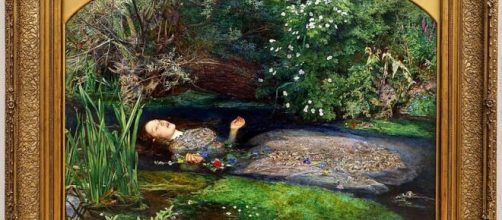New ways to write about art of the past is hard to come by. So much has already been written.
But the Frick Museum found a fresh approach to the 1845 portrait “Comtesse d'Haussonville” by Jean Auguste Dominique Ingres.
In a new book, “Regarding Ingres,” the Frick asked creative writers to imagine tales about the Comtesse based on her backstory.
It’s easy to see why the lady’s bio would be ripe for milking. You might call her a lady in waiting for exploitation owing to her juicy memoirs.
Mirror, mirror on the wall
As the Comtesse famously wrote: “I was destined to beguile, to attract, to seduce, and in the final reckoning to cause suffering in all those who sought their happiness in me.”
Frick’s effort to demonstrate how this portrait inspired writers set me to think of how writers inspired paintings.
Coming quickly to mind was John Everett Millais’s painting “Ophelia.”
Millais pictured Ophelia’s tragic end, her final moments in Act IV of “Hamlet” when she drowns in a river.
When the play is performed, the suicide necessarily takes place off stage. We learned of it from Hamlet’s mother Queen Gertrude, who witnessed Ophelia “in the weeping brook...her garments, heavy with their drink, Pull’d the poor wretch from her melodious lay To muddy death.”
Scholars describe Ophelia’s death as poetic. But it’s hard to find poetry in suicide or even in an accidental death, as Gertrude saw it. Neither is there anything lyric about madness, which Ophelia clearly suffered.
Clearly, Millais sought to prettify Ophelia’s final moments.
He went further than illustrating Gertrude’s description of her being buoyed by air filling her clothing before the river takes+ her.
In Millais’s painting, lush flora edging the river bank lends Ophelia’s death some grace. Bright colors seen in the trees and brush heighten her pale complexion by comparison and speak of life ongoing.
Poetry aside, there were realities behind the scene that paint a different picture. The painting process was hard work. Millais worked on the painting 11 hours a day, six days a week for six months.
And there were challenges. As the painter wrote to a friend, flies were a problem “more muscular... with a greater propensity for probing human flesh.”
The model for Ophelia was the poet and painter Elizabeth Siddal, and she suffered for it.
At the time, she was only 19 years old and to pose as “Ophelia,” she had to lie in a filled bathtub fully clothed for hours at a time.
The modeling took place in the winter in Millais’s London studio and even though he set oil lamps under the bathtub to warm the water, he tended to let the lamps go out as he focused on his painting.
As a result, Siddal got sick, and her father had to ask Millais to reimburse him for his medical bill. With all this reality in mind, picturing Ophelia’s suicide seems less poetic, and more of a punishment.
Reality bites
Then there’s a CDC survey of teen girls showing that nearly a third say they have considered taking their own lives.
With news like that, the Frick ought to consider showing Millais’s painting with the gritty behind-the-scene information so Ophelia’s suicide won’t be idealized by teen girls.
Glorifying bad stuff is an old habit in the art world. Peter Paul Rubens describes men seizing women like a playful romp in "The Rape of the Daughters of Leucippus."
Painters like Millais and Rubens, tend to romanticize the unromantic. A more sensitive display of their work is called for, don’t you think?


